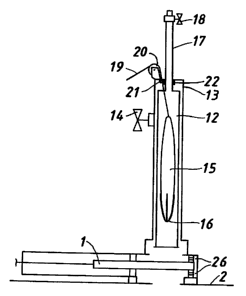Some of the information on this Web page has been provided by external sources. The Government of Canada is not responsible for the accuracy, reliability or currency of the information supplied by external sources. Users wishing to rely upon this information should consult directly with the source of the information. Content provided by external sources is not subject to official languages, privacy and accessibility requirements.
Any discrepancies in the text and image of the Claims and Abstract are due to differing posting times. Text of the Claims and Abstract are posted:
| (12) Patent: | (11) CA 2318773 |
|---|---|
| (54) English Title: | PIPE THREADING ARRANGEMENT |
| (54) French Title: | ENSEMBLE GUIDE-TUYAU |
| Status: | Deemed expired |
| (51) International Patent Classification (IPC): |
|
|---|---|
| (72) Inventors : |
|
| (73) Owners : |
|
| (71) Applicants : |
|
| (74) Agent: | GOWLING WLG (CANADA) LLP |
| (74) Associate agent: | |
| (45) Issued: | 2003-10-28 |
| (86) PCT Filing Date: | 1999-01-19 |
| (87) Open to Public Inspection: | 1999-08-12 |
| Examination requested: | 2000-07-27 |
| Availability of licence: | N/A |
| (25) Language of filing: | English |
| Patent Cooperation Treaty (PCT): | Yes |
|---|---|
| (86) PCT Filing Number: | PCT/GB1999/000168 |
| (87) International Publication Number: | WO1999/040661 |
| (85) National Entry: | 2000-07-27 |
| (30) Application Priority Data: | ||||||
|---|---|---|---|---|---|---|
|
A pipe threading arrangement includes a launch body (13) and a parachute (15)
within tube (12). The parachute is launched into pipe (2) via slide valve (1)
and brings with it a threading cable (19). At a remote location within the
pipe (2) the parachute is stopped by a catch arm (8) with associated catch
finger (5). The parachute is deflated and retrieved, together with the
threading cable, via the slide valve into the catch body (4).
L'invention concerne un ensemble guide-tuyau comprenant un dispositif de lancement (13) et un parachute (15) à l'intérieur d'un tube (12). Le parachute est projeté dans un tuyau (2) grâce à un distributeur à tiroir (1), ce parachute entraînant avec lui un fil de guidage (19). Ce parachute est ensuite immobilisé, à un emplacement éloigné à l'intérieur dudit tuyau (2), par un bras de blocage (8) pourvu d'un doigt de blocage (5). Ce parachute finit par se dégonfler avant d'être retiré, avec ledit fil de guidage, par l'intermédiaire du distributeur à tiroir situé dans le dispositif de blocage (4).
Note: Claims are shown in the official language in which they were submitted.
Note: Descriptions are shown in the official language in which they were submitted.

For a clearer understanding of the status of the application/patent presented on this page, the site Disclaimer , as well as the definitions for Patent , Administrative Status , Maintenance Fee and Payment History should be consulted.
| Title | Date |
|---|---|
| Forecasted Issue Date | 2003-10-28 |
| (86) PCT Filing Date | 1999-01-19 |
| (87) PCT Publication Date | 1999-08-12 |
| (85) National Entry | 2000-07-27 |
| Examination Requested | 2000-07-27 |
| (45) Issued | 2003-10-28 |
| Deemed Expired | 2006-01-19 |
There is no abandonment history.
| Fee Type | Anniversary Year | Due Date | Amount Paid | Paid Date |
|---|---|---|---|---|
| Request for Examination | $400.00 | 2000-07-27 | ||
| Registration of a document - section 124 | $100.00 | 2000-07-27 | ||
| Application Fee | $300.00 | 2000-07-27 | ||
| Maintenance Fee - Application - New Act | 2 | 2001-01-19 | $100.00 | 2001-01-17 |
| Registration of a document - section 124 | $50.00 | 2001-11-13 | ||
| Maintenance Fee - Application - New Act | 3 | 2002-01-21 | $100.00 | 2002-01-07 |
| Maintenance Fee - Application - New Act | 4 | 2003-01-20 | $100.00 | 2003-01-03 |
| Final Fee | $300.00 | 2003-08-06 | ||
| Maintenance Fee - Patent - New Act | 5 | 2004-01-19 | $150.00 | 2003-12-10 |
Note: Records showing the ownership history in alphabetical order.
| Current Owners on Record |
|---|
| LATTICE INTELLECTUAL PROPERTY LTD. |
| Past Owners on Record |
|---|
| BG INTELLECTUAL PROPERTY LIMITED |
| DELAFORCE, STEPHEN ROBERT |